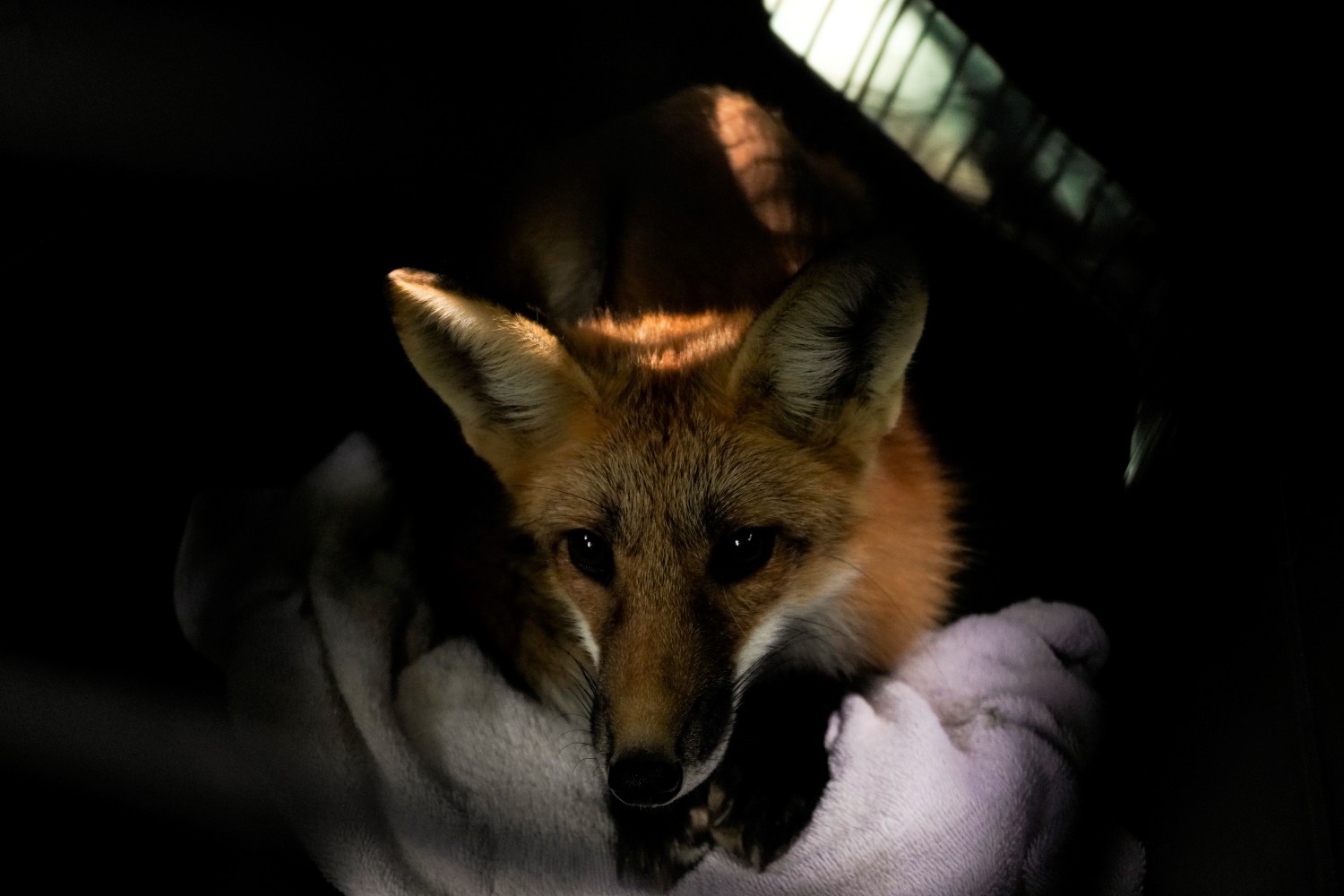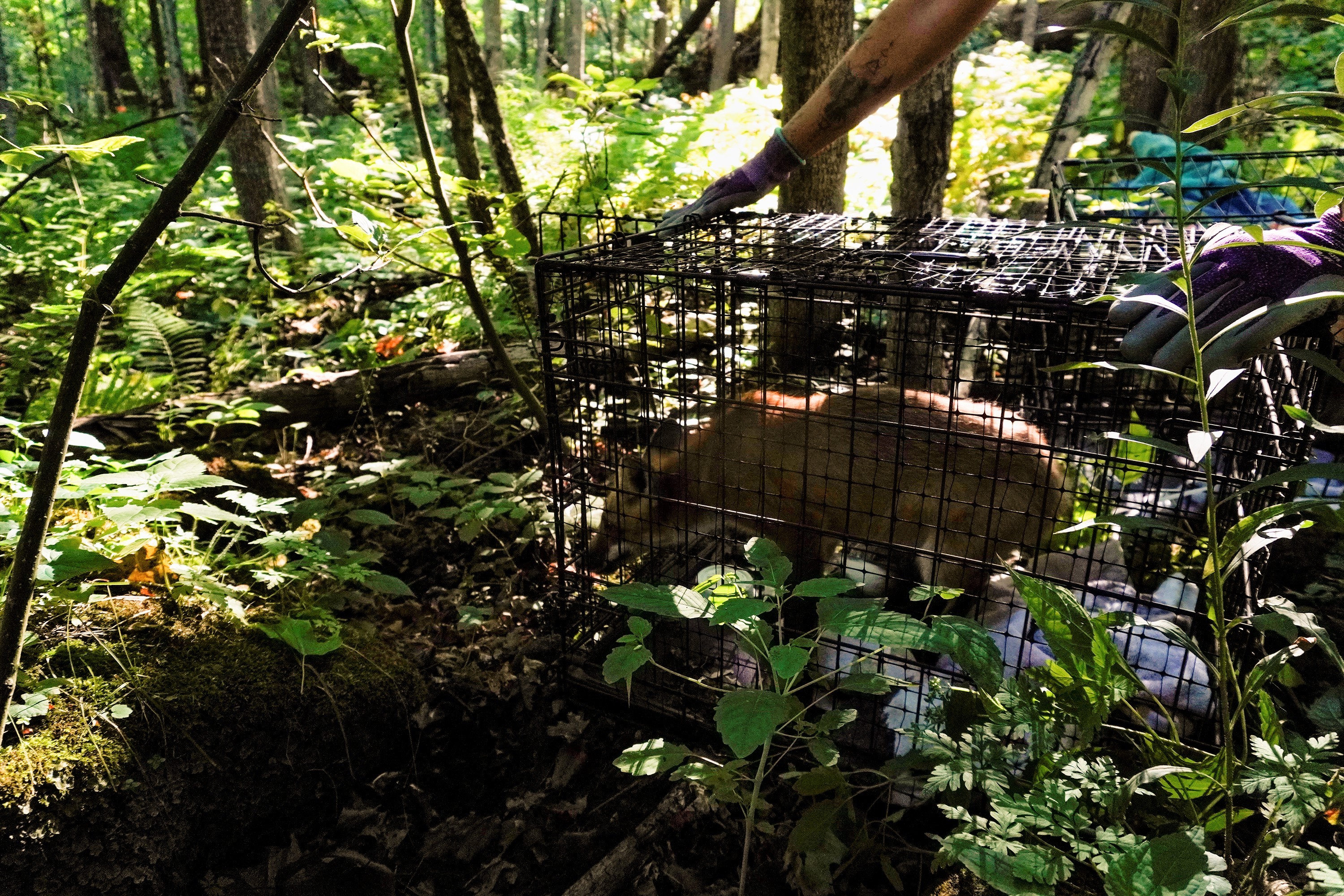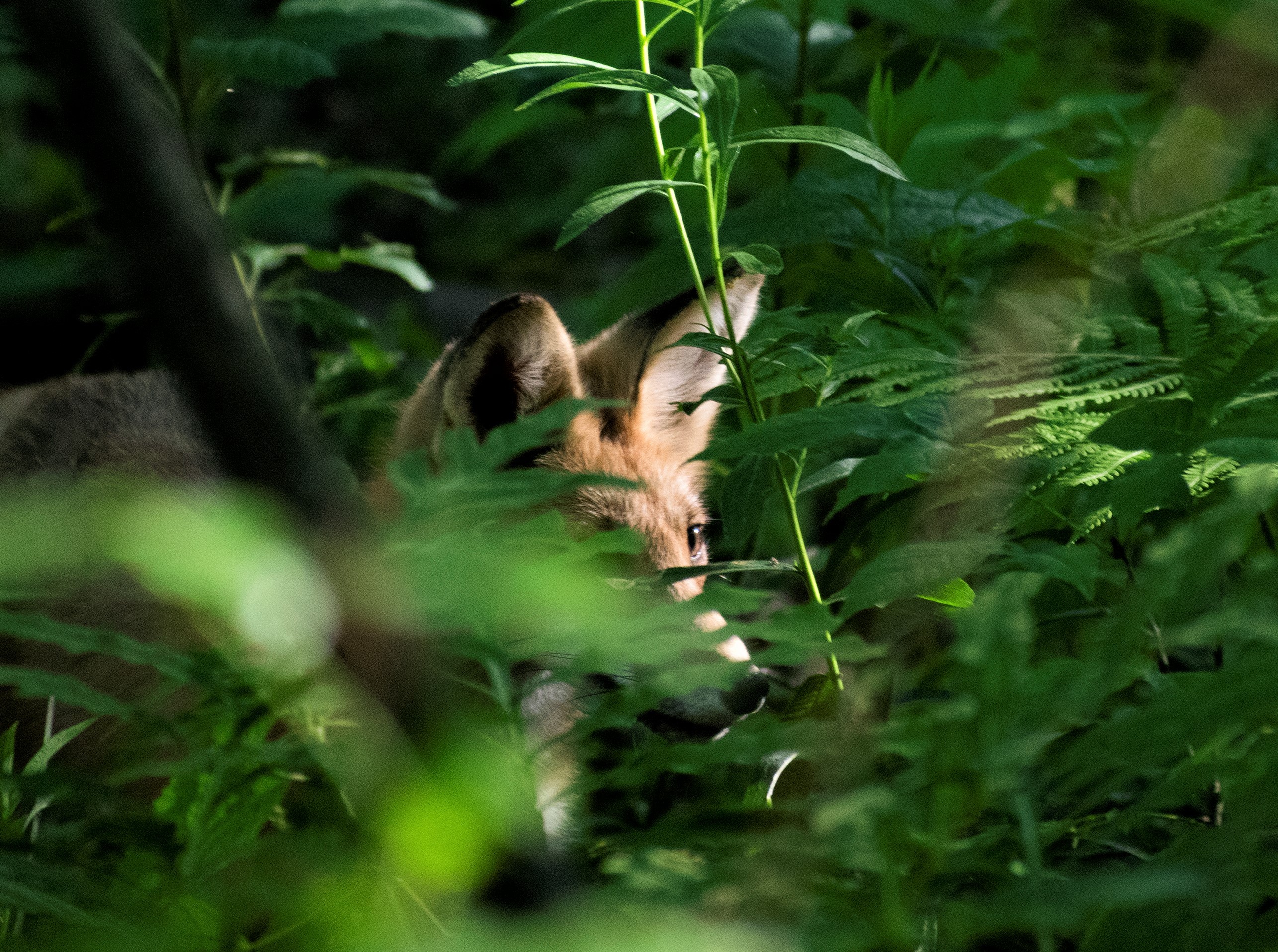
Part 2: Urban fox population illustrates need to protect Ontario’s ecosystems
“They went into the portal.”
There comes a moment when releasing a rescued wild animal feels like they disappear into a ‘portal’. It is often a dense forest or tall grass that suddenly swallows the creature back into its natural habitat where it returns to the perfect hiding place.
The animals who come into the rescue are often injured and eager to get back home. Once healthy they bolt back into the wilderness in a blink of an eye. Sometimes, if you’re lucky, you get to watch them play or explore for a moment, before they disappear forever—hopefully thriving after their rehabilitation journey.
Procyon Wildlife specializes in saving the life of an injured or orphaned being. A licensed, registered charity in Beeton, Ontario operating solely on donations and local sponsors, it sees racoons, squirrels, deer, coyote, possums, rabbits, sometimes birds of prey like hawks, falcons, and owls, small reptiles, and more. Looking after so many animals requires a dedicated team of workers and volunteers, but they are always looking to expand.
Marlena Perich, a volunteer with Procyon for over six years, says the experience of helping wild animals is educational, and unlike any other.
“Working with wild species has been one of the most rewarding experiences of my life. It is a privilege, it is a spiritual journey, it is so many lessons that taught me to be humble and respect the incredible biodiversity Ontario has on a level I can’t put into words effectively,” Perich says. “I get to meet so many wild creatures that most people don’t ever even interact with or get to know how hilarious, complex, intelligent individuals so many are…and how every single one has a purpose, is interconnected in a complex beautiful tapestry or habitat.”
Marlena Perich hikes a release location looking for habitat conditions which will help the rescued animals thrive.
(Alexis Wright/The Pointer)
Each day, the Eastern Grey Squirrel forages the land for insects, vegetation, seeds, nuts, and fruits. Once full, the squirrel then packs the rest of the seeds in the vicinity into its cheeks then buries them in dispersed “hiding places'' or pockets particularly along the forest floor. Burying nearly all of what it finds, a survival tactic to ensure less competition and constant access to a food source, it is estimated that Eastern Grey Squirrels are responsible for at least 30 percent of natural forest regeneration every year.
(Photos by Marlena Perich)
The animals that are brought in need specialized care, having only a slim chance of survival without help. Qualified experts provide medical attention, but more and more often they are seeing orphaned wildlife due to human activity like being struck by vehicles – a concerning upward trend with no plateau in sight. Without rescues to take care of and raise them before being released back where they belong, these orphans likely would not survive and the species’ population would face a more dire fate. Many are already on the brink, or not far from it.
Caring for wild animals comes with breathtaking and heartbreaking experiences. Trying to keep a wild animal “wild” is complicated when unavoidable human attachment after months of care can prevent adaptation to harsh conditions that surround animals in their natural environment. This is the biggest challenge faced when caring for imprinting animals like deer.
A growing concern at Procyon when foxes are brought in is rodenticide. Rats can bring along diseases if their populations aren’t naturally controlled by predators, but humans have, once again, intervened by killing off even healthy populations using poisons that are then ingested by foxes and other predators who then become poisoned too. With consistent exposure, over time the fox's immune system becomes weakened enought to be highly susceptible to illness. If brought to the rescue in time it's often easily treatable, however, removing the risks associated with using poison is what's really needed.


A rescued fox is returned to its natural habitat. The Red Fox is the largest of 12 species of true foxes in the world. Their small size is deceiving as they are the top predator of their food chain, aside from Humans. In 2002, Scotland banned fox hunting, two years later England and Wales followed. They have been protected for over 100 years by the 1911 Protection of Animals Act. According to the Masters of Foxhounds Association of America, there are still nearly 144 organized fox hunting clubs in the U.S. and Canada.
(Alexis Wright/The Pointer)
The red canines are one of the countless species keeping the ecosystem balanced. Highly adaptable to urban environments as well, they feast on small wild mammals, like rabbits and rats, that are known to reproduce at very fast rates. Those smaller animals have roles to maintain the balance; they eat small insects, dropped food like seeds from other animals and vegetation that would otherwise overrun its habitat, but without predators like foxes they would quickly overrun a city – and with exploding populations come the perfect recipe for uncontrollable disease outbreaks.
Foxes have long been described as having no predators, though they do compete with animals such as coyotes for space and food within their habitats. However, another animal, previously not seen in the domain of foxes, is now putting immense pressure on a range of species, threatening the very existence of foxes across much of Ontario. Human activity is driving them from their homes.
The sight of foxes in the GTA has become common; the City of Toronto provides the following information on its website to avoid conflicts with a fox:
- Build a “prevention skirt” to help discourage foxes from making a den.
- Enclose areas underneath patio decks and sheds and other places where foxes may make a den.
- Keep pets inside or supervised outside.
- Foxes will eat garbage and pet food left outdoors.
- Take your green bin and garbage containers to the curb on the morning of pick-up.
- Do not feed pets outside.
- Foxes will be more likely to visit or look for den sites near a home where people stay indoors most of the time.
- If you see a fox in your yard, make loud noises directed at the animal. To chase the fox away, spray it with a garden hose. This will not harm the fox.
This is the human response to a human-made problem, one that harms foxes far more than us.
Though if there is no immediate danger to pets, foxes can be helpful tenants, not a threat. Many people have shared stories about a fox feeling safe enough in a human space to create their own home to grow their family too. If taught to respect wildlife, and interact indirectly from afar, foxes can safely coexist with us at any age. Cohabitation is possible if we understand the existence of countless species that surround and protect us in different ways. Animals like foxes and coyotes are more afraid of humans than we are of them, but our reactions are often driven by fear and lack of education. One way to change these misconceptions and end potentially harmful confrontations (it’s almost always the animal that suffers) is to participate in or encourage schools and communities to provide outdoor education. Witnessing a fox raise kits, for example, is a learning experience for anyone and might prevent reflexive negative reactions toward these creatures as urban interactions become more common due to human activity that has displaced our four-legged visitors from their natural habitat.
“On the other hand I get to experience being at the heart of human wildlife conflict response,” Perich says. “So wildlife rehabilitation has also taught me a lot about loss, grief, suffering, intense work, how not every story ends peacefully, how habitat loss because of urban sprawl, roads that cut through travel or migration routes or block access to integral survival resources like bodies of water, food, shelter. The lack of education of the growing population living closer to wildlife and [people] not understanding crucial coexistence principles that consider wildlife over selfish human interests means the sad cases we get sometimes and we can’t always handle it.”
Habitat fragmentation caused by development of roads and subdivisions results in foxes being killed by vehicles as speeding drivers are often unaware of the vast wildlife that surrounds all cities and towns in Ontario. Complete habitat loss from sprawling subdivisions and massive highways is the biggest human threat, not just to foxes.
(Alexis Wright/The Pointer)
Among many others, porcupines are another species that greatly suffers from the loss of trees for more sprawl as their bodies are designed to climb, not cross pavement. Deforestation slows their movements, making them extremely vulnerable to being hit by vehicles.
Volunteering to help wildlife has great benefits for the animals, and for the humans involved too. Countless studies have documented many positives that arise from spending time in nature—improving mental health for one—helping our natural world survive and thrive can provide a completely different perspective in an increasingly chaotic time.
Spending time helping wild animals can be a benefit to another increasingly prominent challenge humans face today: climate anxiety. Directly giving back to the environment that our behaviours have directly negatively impacted is a very effective way to bring hope back into an otherwise seemingly bleak situation.
Racoons are the scavengers of woodlands. These opportunistic eaters will snack on anything they can get their tiny hands on. Easily adapted to an urban habitat, the masked omnivores thrive anywhere there is access to food and water, although lush greenspace is their preference. A common myth about raccoons is that they like to ‘wash’ their food before eating it; they do not produce saliva and need liquid to help some drier foods go down smoothly.
(Alexis Wright/The Pointer)
Perich says it’s difficult to find people who care enough to stay committed, but it has been rewarding to create friendships with those that do.
“I’ve also experienced community, and what it means when wonderful people come together to do their best to offset the human/wildlife conflict to help as many little and large wild beings that deserve a second chance at life in what can be a mean world.”
It is difficult yet necessary work – especially as habitats are being rapidly lost not only to development but climate change as well, the consequence of our all-consuming human approach to life on Earth.
Many residents across the GTA and other parts of Ontario have seen more and more foxes strutting along their streets and darting into backyards. While they can cohabitate with humans, their long-term survival will be threatened if habitat continues to disappear at the rate of our exploding human population.
(Alexis Wright/The Pointer)
Perich and others committed to rescue work realize in the grand scheme of our environmental crisis, one animal might seem insignificant. But when you view our incredibly complex planetary ecosystem the way it should—as one massive interdependent sphere that sustains all connected life together—removing one key piece in this delicate balancing act is like a game of Jenga.
The whole thing will eventually come crashing down.
Email: [email protected]
Twitter: @lextoinfinity
COVID-19 is impacting all Canadians. At a time when vital public information is needed by everyone, The Pointer has taken down our paywall on all stories relating to the pandemic and those of public interest to ensure every resident of Brampton and Mississauga has access to the facts. For those who are able, we encourage you to consider a subscription. This will help us report on important public interest issues the community needs to know about now more than ever. You can register for a 30-day free trial HERE. Thereafter, The Pointer will charge $10 a month and you can cancel any time right on the website. Thank you
Submit a correction about this story


